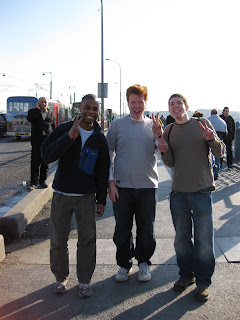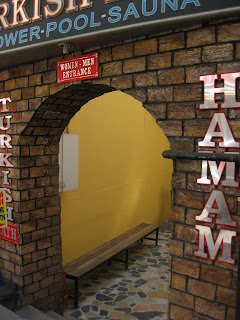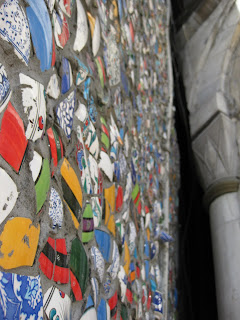
 Agia Sofia
Agia Sofia Inside the Agia Sofia
Inside the Agia Sofia The wishing column
The wishing column
“Grand Bazaar Gate 20” – that was what the marble archway said. However, what it didn’t tell me was that after crossing that threshold, into the oldest market in Istanbul that I would be walking into a whole other world. There was just about everything you could imagine, from touristy merchandise to tea sets to water pipes to meats to spices, all strewn about the shops inside the Grand Bazaar. These shops, rows up rows of shops, all presenting their finest merchandise in either their front window or hanging on ropes outside, waiting for the closest buyer to walk by and then:
“What are you looking at? You like this? How much? 45 Lire! How much you want to spend? 35! No? 25… 20!”
Last weekend, the gentlemen of the Loyola International Nachbahrnhuis took a private gentleman’s trip to the capital of the eastern Roman Empire Constantinople, which has since been renamed Istanbul. Wandering out of Belgium, out of the Schengen, and in this case out of Europe, the 7 Americanos took our sightseeing skills to the city on the eastern edge of Europe.
Being our first trip to an Arab and Muslim state, our journey to Istanbul was a step not only into a new city, but into a new culture and society entirely. The spires of gothic cathedrals were replaced with the tips of mosque minarets. The sound of church bells on the hour was replaced with the call to prayer (which occurred 5 times a day). And the typical transaction between a store owner and a customer, was replaced with haggling and prices changes. These were just a few of the many transitions we noticed over the course of our time walking the streets of Istanbul.
Istanbul was a gorgeous city and we spent a majority of our time there just walking around appreciating the culture and beauty of the Turkish lifestyle and architecture. Our first night in Istanbul, we arrived late, grabbed some food as we walked, and found our way over to our hostel which was in the Sultanahmet region of the city. It was then that we caught our first sight of the Agia Sofia and the Sultanahmet Mosque (The Blue Mosque). These two major religious structures were lit up in bright spotlights and stood out like large white stones among the otherwise dark hillside. After taking in our fair share, we wandered to the hostel and crashed for the evening.
The next morning we were up early and toured the Agia Sofia. The Agia Sofia was completed in 537 by The Byzantine Emperor Justinian and was one of the first churches built in the Eastern Roman Empire. It served as the Cathedral of Constantinople until the 1500’s when the Ottoman empire took over and then converted it into a Mosque, adding the signature minarets. It then served as the main mosque in Constantinople until the 1930’s when it was officially made into a museum. Today the building full of 1500 years of history is a hodgepodge of historical and religious relics of both the Christian and Muslim faiths.
After we toured the Agia Sofia, we headed across the garden in front of the Agia Sofia and into the Blue Mosque. The Sultanahmet Mosque was built by the Sultan Ahmet (buried inside) in 1423 and now serves as the largest Mosque in Istanbul. The mosque is also known as the Blue Mosque because of its ornate interior tiles. Its signature six minarets are the main symbol’s of the mosque (the most minarets outside of Mecca’s 7). We stood for a while inside the Blue Mosque, walking around in our socks, just appreciating the Muslim faith and way of worship. Even as we toured the interior of the building, there were people bowing, kneeling, and standing praying toward Mecca.
It was really a sight to behold and an experience that any person of the non-Muslim faith should undertake. To say it brings a greater appreciation for a religion that in reality I knew very little about would be an understatement. I spent most of my time inside the mosque just in awe, trying to take in as much as I could. There is a reason that the Blue Mosque is hailed as one of the major attractions in Istanbul, and I think the 7 of us all understood that thoroughly after the hour we spent just admiring its interior.
Once we finished touring around Sultanahmet we began to wander the narrow and often times confusing streets of the city toward the Spice Bazaar. The Spice Bazaar was in the olden days where the people of Istanbul would gather to buy spices from all over the world. Because of its unique location, Istanbul was often the center of spice trade between the Orient and Europe. As a result, the spice market has been a long standing tradition. Most of the shops were true to its reputation, with piles and piles of different spices – reds, oranges, and yellows – casting an equally colorful scent through the air. The spice market was also a place to find relatively cheap food (1.50 Lire or .75 Euros for a Kebab) and inexpensive touristy gifts (as a result did most of our eating and shopping around the Spice Market).
Once we got through the spice market, we headed toward the bridge to cross over into Asia (that’s right my 3rd ever continent). Unfortunately there wasn’t much going on in the Great Orient, so we wandered back across and found our way over to the Grand Bazaar. The Grand Bazaar (described above) was a spectacle like nothing else I’ve ever seen, and we returned to it a number of times over the course of our trip. That night we caught some traditional Turkish cuisine at a restaurant next to our hostel and then spent the evening with 2 water pipes, just relaxing and enjoying the simple lifestyle in Istanbul.
Our second day in Istanbul began a little bit earlier, as we were up early for our trip to a 500 year old Turkish bath. The experience was definitely something new for us as a Traditional Turkish bath involves a sauna, a pool, and being soaped up and massaged by a rather large Turkish man – it was every bit as weird and relaxing as I just made it sound.
Though we had a car that picked us up at our hostel to take us to the bath, we were left on our own to find our way back. After wandering the street for a bit, getting lost in the oldest and narrowest parts of Istanbul, we eventually (with help from an Irishman) found our way back to the Blue Mosque and back to our hostel. Once we got back and changed, we headed back out to see the city again. We wandered around the grounds of the Topkapi Palace, and then made our way back toward the Grand Bazaar for some souvenir shopping, stopping first to tour the large underground Cistern, which was used to supply water to the city nearly 1500 years ago. The Cistern is known as “the Basilica” because it is said to be as large as a Basilica, and the water that still currently runs through the cistern comes from an old Roman aqueduct that beings nearly 15 miles outside the city.
We spent our last night in Istanbul wandering through the Grand Bazaar and the streets of the old city, eating Kebaps (roughly 5 of them) for both lunch and dinner. Our time in Istanbul had been relaxing to say the least, but most of all was an awesome trip for the gentlemen in the group to just hang out and enjoy each other’s company.
The next morning we were up with the morning call to prayer (roughly 4:30 am) and out of bed by 6:30. We had an early flight back to Brussels by 10am. As we drove along the waterfront, watching the rising sun over the Mediterranean Sea, we had finished our time in Turkey, and headed back home to Belgium.























No comments:
Post a Comment